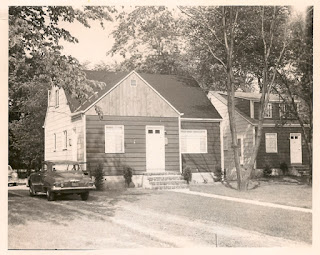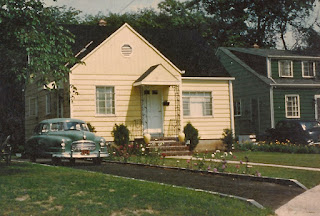A Change of Careers
Way back at the beginning of this blog I wrote about a birth certificate that I had for my grandfather, Wallace B. Dixon. In that post, after recording the facts on the document, I was left with two questions.One was about the family story that claimed that my grandfather changed his name. Sending off to the NJ State Archives for his original birth record answered that question, and I wrote all about it in the post "Wallace B. Dixon : Name Changer."
The second question centered around his father's occupation as listed on the birth document. I knew from previous research that many of the Dixon men worked as oystermen. The birth document gave William A. Dixon's occupation as "carpenter." I wondered if he had ever worked as an oysterman, and if so, when he made a change of careers.
Comparing the documents that I have found for William A. Dixon thus far showed that he did work as an oysterman. The earliest record is the 1880 United States Census, which shows that William, aged 17, worked at "oystering." (1)
| 1880 US Census entry for William A. Dixon. Ancestry.com. Family History Film 1254800. |
Both his marriage record (2) and an entry in the Elizabeth City Directory for 1883 (3) also give his occupation as "Oysterman." So do the birth records for his son William J. Dixon (1885) and an unnamed son, probably George Thomas Dixon (1897).(4, 5)
His switch of careers to "Carpenter" first appears in the 1900 U.S. Census.(6)
This is interesting, because by 1900 the oyster industry in the waters surrounding New Jersey and New York had begun a serious decline due to over-harvesting of the oysters and increase in pollutants and sewage dumped into the coastal waters. Increasing concerns about food quality and sanitation also played a part in the decline of the oyster as a major food product of the area, and in the country at large. (7)
It is possible that William foresaw the decline of the oyster industry. It is also possible that with the responsibility to provide for a growing family (five children were in the household by 1900) he realized that more stable year-round employment was needed. Oyster harvesting was, by law, limited to certain months of the year. William's Uncle, Asa Dixon, had been shot and killed in 1866 while poaching oysters out of season.
So, at some time between 1897 and 1900 William gave up harvesting oysters and took up carpentry. We also see the same occupation on the birth records for his two youngest children, Wallace Bernard Dixon, b. 1905 (8) and Hazel Dorothy Dixon, b. 1909.(9) [On the latter he is a Carp Ender. You can read more about that here.]
 |
| William Dixon, death certificate No. 611 (23 May 1927), Elizabeth, NJ. NJ State Archives. |
Sources
[1] 1880 U.S. Census, Union County,New Jersey, population schedule, Elizabeth, enumeration district (ED) 164, 23-24, dwelling 184; family 226, William Dixon; digital images, Ancestry.com (http://www.ancestry.com : downloaded 31 July 2015); Roll 800; Family History Film: 1254800; Page 40D; Enumberation District: 164; Image: 0084.
[2] State of New Jersey Marriage Return, Marriage Return, William A. Dixon Mary Elizabeth Clyne, 22 August 1883; New Jersey State Archives, Trenton.
[3] "U.S. City Directories, 1822-1995", database, Ancestry.com Operations, Inc., Ancestry.com (http://www.ancestry.com : accessed 23 April 2016), page 87, William A. Dixon; citing "Cook & Hall's Elizabeth City Directory for 1883-84 (Elizabeth, N.J.: Elizabeth Herald Steam Printing House, 1883)," oysterman; boards at 107 Elizabeth Ave.
[4] William J. Dixon, birth certificate (12 November 1884), New Jersey State Archives, Trenton, New Jersey.
[5] [Unnamed Male Child] entry, Elizabeth, New Jersey Births: D40, New Jersey State Archives, Trenton, New Jersey.
[6] 1900 U.S. Census, Union County, New Jersey, population schedule, 5th Ward, enumeration district (ED) 102, Sheet Number 7, dwelling 83, family 180, William A. Dixon; digital images, Ancestry.com (http://www.ancestry.com : downloaded 5 March 2015); United States of America, Bureau of the Census. Twelfth Census of the United States, 1900. Washington, D.C.: National Archives and Records Administration, 1900. T623, 1854 rolls.
[7] For information on the history of the oyster industry in and around New York City and New Jersey see the following web sites:
- New York / New Jersey Baykeeper : About the Oyster
- Feeding New York : A Historical Geography of Food in New York City. Chapter 9: Feeding a Growing City: Changes in New York food production and consumption, 1860 to 1940. By Ann Paul, Daniel Salgado, Michael Sanduski, Krishan Sharma, Joe Tesoro, Sean Winker.
- History on the Half Shell: The Story of New York City and Its Oysters. Carmen Nigro, Stephen A. Schwarzman Building, Milstein Division of United States History, Local History and Genealogy, New York Public Library. 2 June 2011.
- "The Oyster Farmer." edibleJersey: Celebrating Local Foods of the Garden State, Season by Season. Diana Cercone. High Summer 2014.
- Clyde L. MacKenzie, Jr. History of Oystering in theUnited States and Canada, Featuringthe Eight Greatest Oyster Estuaries. PDF Document. National Oceanic and Atmospheric Administration.
[9] Hazel Dorothy L. Dixon, birth certificate 79 (16 January 1909), Elizabeth, Union County, New Jersey New Jersey State Archives, Trenton, New Jersey.
[10] William Dixon, death certificate No. 611 (23 May 1927), New Jersey Department of Health, Bureau of Vital Statistics, Trenton, New Jersey.








![Marriage Document for William A. Dixon and Mary Elizabeth Clyne [Klein] 1883, Elizabeth, NJ. From N.J. State Archives, Trenton. Marriage Document for William A. Dixon and Mary Elizabeth Clyne [Klein] 1883, Elizabeth, NJ. From N.J. State Archives, Trenton.](https://blogger.googleusercontent.com/img/b/R29vZ2xl/AVvXsEg8grVNyh6HY1FEk7subWEvvspcPN-XuPo1lw6NUUaOfEuo7SY0mVHlxuhdjlMfteXtaKxu5GZ2AP2jTJdonuiJvy-_EceWCjhu53YX77Sw2REwFhxMqAuZnftMb7uTRbErnux4LWUB99Bw/s320/DIXON-William_KLEIN-Mary_Elizabeth_marriage-1883.jpg)









